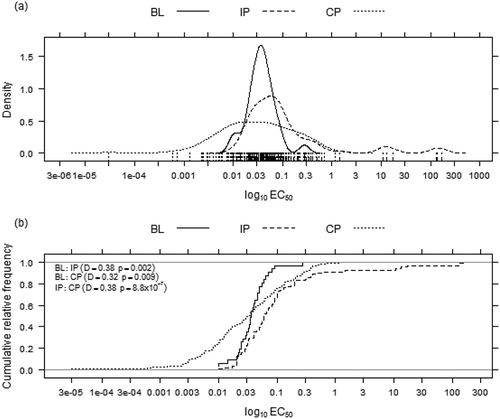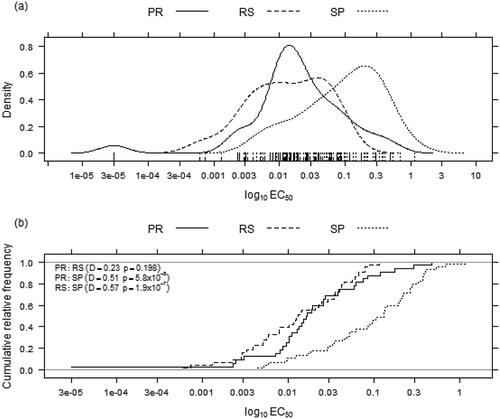Figures & data
Table 1. Location, year and Monilinia fructicola isolate codes sampled for this study.
Fig. 1 Frequency of Monilinia fructicola sensitivity to tebuconazole among the isolates collected between 2009 and 2011 based on the relative growth under the discriminatory dose of 0.3 µg mL−1 method (a), the EC50 value using the 0.3 µg mL−1 as the discriminatory dose (b) and the EC50 value using the baseline value of 0.046 µg mL−1 as the discriminatory dose (c). SP = São Paulo, PR = Paraná, RS = Rio Grande do Sul, R = resistant, and S = sensitive. The entire values correspond to the sample size, and values in brackets correspond to the percentages [n (%)].
![Fig. 1 Frequency of Monilinia fructicola sensitivity to tebuconazole among the isolates collected between 2009 and 2011 based on the relative growth under the discriminatory dose of 0.3 µg mL−1 method (a), the EC50 value using the 0.3 µg mL−1 as the discriminatory dose (b) and the EC50 value using the baseline value of 0.046 µg mL−1 as the discriminatory dose (c). SP = São Paulo, PR = Paraná, RS = Rio Grande do Sul, R = resistant, and S = sensitive. The entire values correspond to the sample size, and values in brackets correspond to the percentages [n (%)].](/cms/asset/1a4b8195-876c-4978-876d-16798a06d40a/tcjp_a_1147496_f0001_b.gif)
Table 2. Comparison of the effective concentrations of tebuconazole required for 50% population inhibition (EC50 value) of the Monilinia fructicola isolates from three different populations in Brazil.
Fig. 2 Monilinia fructicola density distributions (a) and cumulative relative frequencies (b) for the tebuconazole effective concentration for 50% population inhibition (EC50) in Brazil comparing the baseline (BL, 2000–2004), intermediate (IP, 2005–2008) and current (CP, 2009–2011) populations.

Table 3. Comparisons of effective concentrations of tebuconazole required for 50% population inhibitions (EC50 value) of Monilinia fructicola isolates collected between 2009–2011 in São Paulo (SP), Paraná (PR) and Rio Grande dos Sul (RS).
Fig. 3 Monilinia fructicola density distributions (a) and cumulative relative frequencies (b) of the tebuconazole effective concentrations required for 50% population inhibition (EC50) in Brazil comparing the origins within the actual population (2009–2011). SP = São Paulo, PR = Paraná, RS = Rio Grande do Sul.

Table 4. Mean tebuconazole sensitivity differences due to Monilinia fructicola storage.
